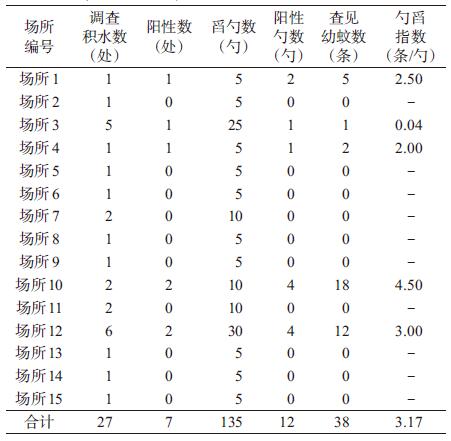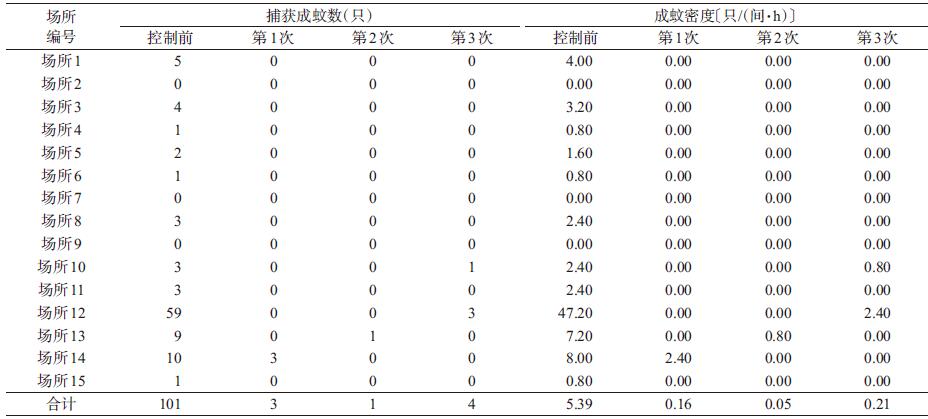
扩展功能
文章信息
- 陈红, 周毅彬, 单宁
- CHEN Hong, ZHOU Yi-bin, SHAN Ning
- 上海市静安区地下空间冬季蚊虫组成及控制研究
- A study of mosquito composition and control in underground spaces of Jing'an district, Shanghai, China in winter
- 中国媒介生物学及控制杂志, 2020, 31(5): 571-574
- Chin J Vector Biol & Control, 2020, 31(5): 571-574
- 10.11853/j.issn.1003.8280.2020.05.014
-
文章历史
- 收稿日期: 2020-04-24
2 上海市疾病预防控制中心, 上海 200336
2 Shanghai Municipal Center for Disease Control and Prevention
越冬蚊虫是次年蚊虫孳生的基础,其数量直接影响次年早春首代蚊虫的密度,进而影响蚊媒传染病的传播与流行风险[1]。近年来,随着经济发展,大型城市的房屋类型也随之改变,地下区域成为蚊虫越冬的主要场所。调查结果显示,大型城市蚊虫越冬的场所中地下空间(包括停车库、防空洞等)占较高比例[2-3]。城市建设的推进以及蚊虫越冬场所的变化,导致了冬季蚊虫构成的变化,并有可能直接影响蚊虫的越冬行为。近年研究指出,地下空间由于四季温度较高,冬季仍有尖音库蚊复合组(Culex pipiens complex)繁殖[4-5],在上海市地下车库发现的尖音库蚊复合组主要包括淡色库蚊(Cx. pipiens pallens)、骚扰库蚊(Cx. pipiens molestus)和致倦库蚊(Cx. pipiens quinquefasciatus)[6],不同车库类型蚊种组成也各不相同。不同蚊种中,淡色库蚊以滞育方式越冬[7],而骚扰库蚊则自育继续繁殖[8]。冬季地下空间蚊种组成的差异将进一步导致不同场所蚊虫越冬行为的差异,为开展冬季蚊虫控制带来新的挑战。
自2016年撤二(原静安区,原闸北区)建一以来,新静安区各类环境进一步丰富,大型城市中心城区和城乡结合部的环境特点兼而有之。此次调查旨在通过调查静安区冬季地下空间蚊虫孳生情况及组成,识别蚊虫的越冬状态,并针对主要蚊种探索有效的控制方法,研究结果有较好的代表性。
1 材料与方法 1.1 调查点选择选择2017—2018年发现冬季蚊虫活动的地下室、地下车库、防空洞等地下空间,在每个场所按照东、南、西、北、中各选择1个监测点开展调查,共计调查15处地下空间作为实验组并实施控制,同时选择27处地下空间作为对照组,在实验组控制完成后同期开展成蚊密度调查。
1.2 研究内容2019年1月,通过对实验组地下空间阳性积水投放1%双硫磷颗粒剂(安备)实施控制,按照2 g/m2(严重污染水体按照5 g/m2)投药。投药前及投药后每隔10 d对实验组重复人工小时法及勺舀法调查,在控制前及控制后30 d对对照组开展人工小时法调查,调查后解剖捕获成蚊,并记录成蚊卵巢发育、吸血和脂肪体发育情况,通过与控制前密度比较、同期对照组地下场所成蚊密度比较,评估控制效果。
1.3 调查方法按照GB/T 23797-2009 《病媒生物密度监测方法蚊虫》进行[9]。
1.3.1 人工小时法在地下空间采用手电筒照明,并使用电动吸蚊器捕获栖息的蚊虫,捕获蚊虫15 min,记录捕获场所类型、捕获蚊虫数量及种类等,并现场记录温度、湿度。
1.3.2 勺舀法在地下空间内查找各类积水,并采用勺舀法调查幼蚊密度。采用500 ml采水勺迅速从水体中舀水,每处积水舀5勺水,记录捞勺数及阳性勺数,吸出阳性勺中幼蚊并放入已编号的采样管中,分类、计数。同时记录日期、场所及积水类型。
1.4 气象数据温度、湿度等数据来源于http://sh.weather.com.cn/。
1.5 统计学分析采用SPSS 16.0软件进行统计分析,成蚊密度采用Wilcoxon秩和检验比较。P < 0.05为差异有统计学意义。

|
此次研究共调查15个有既往发现冬季蚊虫活动的地下空间作为实验组,27个地下场所作为对照组,采用人工小时法调查成蚊密度。
实验组调查点平均温度为10.76 ℃,平均湿度为56.96%,共计捕获成蚊101只,平均成蚊密度为5.39只/(间·h),均为尖音库蚊复合组,其中雌蚊92只,占91.09%,调查场所中捕获成蚊的有12处(占80.00%),其中捕获雄蚊的场所占33.33%;对照组平均温度为8.58 ℃,平均湿度为58.67%,捕蚊情况见表 1,控制前实验组与对照组成蚊密度差异无统计学意义(F=1.084,P=0.278)。

|
对捕获雌蚊进行解剖,实验组解剖92只,卵巢发育雌蚊5只,占5.43%;吸血雌蚊1只,占1.09%,脂肪体积累雌蚊14只,占15.22%,调查场所中,有4处地下空间查见卵巢发育或吸血雌蚊,占26.67%。对照组解剖182只,卵巢发育雌蚊4只,占2.20%;吸血雌蚊1只,占0.55%,脂肪体积累雌蚊35只,占19.23%,见表 2。

|
实验组地下空间蚊虫孳生地调查查见27处积水,均为雨水井/集水井,查见阳性7处,阳性率为25.93%;舀135勺,阳性12勺,勺舀指数为3.17条/勺。见表 3。

|
实施控制后,实验组每10 d开展1次勺舀法及人工小时法调查,调查发现雨水井、集水井在重复调查中均未发现阳性;首次现场捕获成蚊的12处场所在实施雨水井控制后,成蚊密度均有下降,其中仅4处(33.33%)在后续重复调查中捕获成蚊,成蚊密度在第1次控制后下降至0.16只/(间·h),第2次下降至0.05只/(间·h),第3次密度有所回升,为0.21只/(间·h),控制完成前、后成蚊密度差异有统计学意义(F=3.186,P=0.001)。见表 4。

|
控制30 d后,采用人工小时法调查对照组地下空间27处,捕获成蚊219只,平均成蚊密度为6.49只/(间·h)。控制后对照组高于实验组(F=2.823,P=0.005)。见表 5。

|
本研究发现,冬季地下空间温度较高,有73.33%的场所温度高于10.00 ℃,最高达14.50 ℃,同期静安区平均气温最低2.00 ℃,最高8.00 ℃,提示地下区域温度显著高于室外温度,为蚊虫提供了有利条件。而此次研究在地下区域雨水井和集水井中发现幼蚊孳生,说明冬季在温度和湿度适宜的地下区域仍有蚊虫繁殖。
3.2 冬季地下空间蚊虫构成黄慧敏等[3]研究指出,判断蚊虫滞育有4个条件:①冬季不出现雌蚊吸血;②雌蚊卵巢不发育;③雌蚊体内有脂肪体堆积;④无雄蚊产生。而此次调查的地下场所中,33.33%的场所仍有雄蚊,26.67%的场所仍有吸血或卵巢发育的雌蚊,解剖的雌蚊中,仅有15.22%体内有脂肪体堆积,仅部分场所符合蚊虫滞育的判定条件。此外,实施控制后,对照组场所内温度较控制前高,成蚊密度继续上升,而实验组较控制前成蚊密度有显著下降,提示冬季地下空间蚊虫仍在繁殖,而对蚊虫孳生地的控制能有效减少蚊虫密度。上述研究结果说明,静安区地下空间冬季蚊虫应为尖音库蚊复合组,且以仍在繁殖的骚扰库蚊为主。少部分场所控制后仍有成蚊,应为滞育的淡色库蚊,与周毅彬等[4]研究结果相一致。
3.3 地下空间蚊虫控制特点及措施本研究发现,地下区域冬季积水类型单一,均为雨水井、集水井等。雨水井、集水井作为地下区域的主要孳生地,受外界气候影响较小,实施控制后控制效果能保持较长时间。此外,由于冬季蚊虫整体活动度较低,繁殖能力不强[10],此次调查的雨水井、集水井在实施药物控制后1个月内,相应区域内积水阳性数均维持在较低水平,成蚊密度较控制前及同期其他未控制场所均有显著下降,其中有66.67%的场所未再查见成蚊。说明冬季实施雨水井、集水井等蚊虫孳生地的药物控制,对冬季仍在繁殖的骚扰库蚊有较好的控制效果,结合针对越冬的淡色库蚊等成蚊灭杀来控制冬季蚊虫更经济高效。
此次调查中,有12个实验组场所成蚊密度较其他场所高,分析原因发现这些场所为恒温、恒湿的高端住宅,其相对稳定的温湿度更利于冬季蚊虫的孳生和栖息。随着居住环境的优化,恒温、恒湿技术在住房建设中使用越来越广泛,可能对冬季蚊虫的繁殖产生影响,在今后可开展进一步研究。
| [1] |
奚国良. 不同季节蚊虫密度之间的关系分析[J]. 中国媒介生物学及控制杂志, 1999, 10(5): 347-348. G L. Analysis of the relations among the density of mosquitoes in the different seasons[J]. Chin J Vector Biol Control, 1999, 10(5): 347-348. DOI:10.3969/j.issn.1003-4692.1999.05.009 |
| [2] |
王云波, 潘京海, 魏绪强, 等. 北京市东城区城市化发展过程中蚊虫越冬场所变化和防控策略[J]. 医学动物防制, 2016, 32(5): 558-560. Y B, Pan JH, Wei XQ, et al. Changing of mosquito wintering site and control strategy in the development process in Dongcheng district of Beijing city[J]. J Med Pest Control, 2016, 32(5): 558-560. DOI:10.7629/yxdwfz201605031 |
| [3] |
黄惠敏, 姬淑红, 江勤康, 等. 上海市杨浦区越冬蚊调查结果分析[J]. 上海预防医学杂志, 2006, 18(6): 271-272. H M, Ji SH, Jiang QK, et al. Analysis on the result in survey of mosquitoes survived the winter in Yangpu district Shanghai[J]. Shanghai J Prevent Med, 2006, 18(6): 271-272. DOI:10.3969/j.issn.1004-9231.2006.06.006 |
| [4] |
周毅彬, 朱江, 范明秋, 等. 上海市冬季尖音库蚊复合组现状初步研究[J]. 寄生虫与医学昆虫学报, 2014, 21(2): 117-122. Y B, Zhu J, Fan MQ, et al. Ecological situation of Culex pipiens complex in winter, Shanghai[J]. Acta Parasitol Med Entomol Sin, 2014, 21(2): 117-122. DOI:10.3969/j.issn.1005-0507.2014.02.008 |
| [5] |
曹晖, 高强, 樊坚, 等. 上海市黄浦区101个地下车库蚊虫孳生情况及应对措施分析[J]. 中国媒介生物学及控制杂志, 2016, 27(2): 155-159. Cao H, Gao Q, Fan J, et al. Mosquito breeding and countermeasures in underground garages in Huangpu district, Shanghai[J]. Chin J Vector Biol Control, 2016, 27(2): 155-159. DOI:10.11853/j.issn.1003.8280.2016.02.016 |
| [6] |
张杰, 姬淑红, 陆崇华, 等. 上海市杨浦区地下车库蚊虫种类调查[J]. 中国媒介生物学及控制杂志, 2017, 28(1): 38-41. Zhang J, Ji SH, Lu CH, et al. Investigation on mosquito species in underground garage in Yangpu district of Shanghai[J]. Chin J Vector Biol Control, 2017, 28(1): 38-41. DOI:10.11853/j.issn.1003.8280.2017.01.011 |
| [7] |
许峰, 李澜, 许志隆, 等. 上海市金山区越冬蚊虫状况初步调查[J]. 中华卫生杀虫药械, 2015, 21(3): 272-274, 278. Xu F, Li L, Xu ZL, et al. Investigation on overwintering mosquitoes in Jinshan district of Shanghai[J]. Chin J Hyg Insect Equip, 2015, 21(3): 272-274, 278. DOI:10.19821/j.1671-2781.2015.03.019 |
| [8] |
姬淑红, 赵彤言, 冷培恩, 等. 骚扰库蚊上海新纪录及其自育性及对4种杀虫剂的抗性水平研究[J]. 寄生虫与医学昆虫学报, 2010, 17(3): 170-173. S H, Zhao TY, Leng PE, et al. A new record of Culex pipiens molestus in shanghai and studies of autogeny and resistance to four insecticides[J]. Acta Parasitol Med Entomol Sin, 2010, 17(3): 170-173. DOI:10.3969/j.issn.1005-0507.2010.03.010 |
| [9] |
中华人民共和国国家质量监督检验检疫总局, 中国国家标准化管理委员会. GB/T 23797-2009病媒生物密度监测方法蚊虫[S].北京: 中国标准出版社, 2009. General Administration of Quality Supervision, Inspection and Quarantine of the People's Republic of China, Standardization Administration. GB/T 23797-2009Surveillance methods for vector density-Mosquito[S]. Beijing: Standards Press of China, 2009. |
| [10] |
郑朝军, 郁世芳, 凌雪还. 暖冬对蚊虫影响的调查[J]. 医学动物防制, 2001, 17(6): 291-292. C J, Yu SF, Ling XH. Investigation on the effect of warm winter on mosquitoes[J]. J Med Pest Control, 2001, 17(6): 291-292. DOI:10.3969/j.issn.1003-6245.2001.06.007 |
 2020, Vol. 31
2020, Vol. 31



